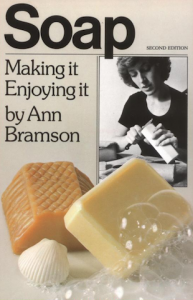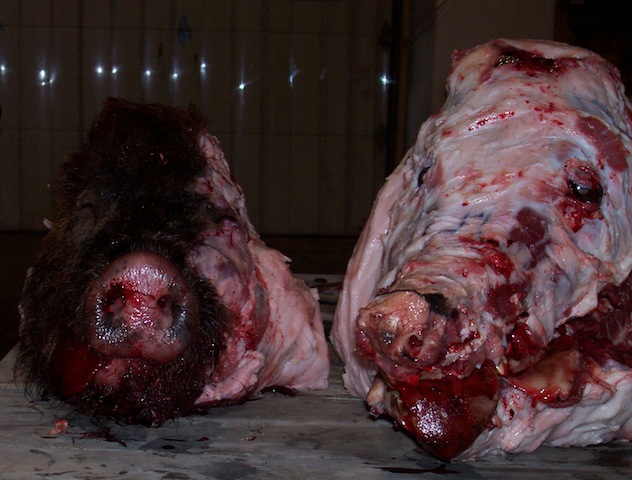Fall and winter are the traditional times for slaughtering, rendering and soap making. Soap is just one of many by-products of the slaughtering process. Ideally, you want to render beef or sheep?suet,?which is the hard fat from around the kidneys and loin. Or you can buy?tallow, which is the rendered suet. If you cannot find suet, any beef or sheep fat will render into a suitable tallow for cooking, candle and soap making. Suet is a traditional base ingredient in?suet pudding and pastry crusts.
Rendering Tallow
5 pounds of beef or sheep suet, chopped into small chucks
2-3c water
1tsp sea salt
1tsp baking soda, optional
Chop the suet into small chucks and put into a large pot. Add water and bring to a boil. Reduce heat to a simmer and cook until all the fat is released. Sieve the fat and water to remove any remaining solid pieces of meat or connective tissue. (If you are making soap and find there is an unpleasant beefy smell, the tallow can be “deodorized” by adding a small amount of baking soda.) Refrigerate until the tallow congeals on the surface of the water. Remove the tallow from the water and scape off any impurities found on the bottom of the tallow. The tallow will store almost indefinitely in the freezer and can be used for cooking, soap and candle making.
Soap making is very easy. I have used a number of soap making books over the years but I have found Soap: Making it, Enjoying It by?Ann Bramson, the easiest to use. If you have never made soap before this book will be very helpful. She has a number of basic soap making recipes but my favorite is her?Castile Soap and Copra-Olive Oil Soap.?The most important part of soap making is measuring carefully and getting the temperature right. It is easier to have two thermometers: one for the lye solution and one for the fats.
Castile Soap
11 ounces lye
32 ounces water
26 ounces of extra virgin olive oil
60 ounces of tallow
1 ounce of essence oil of choice
Note About Ingredients
In the old days, I would use the cheapest ingredients I could find for soap making. I would use pomace olive oil. The more I learn about industrial food processing, the more careful I become. Pomace olive oil is made by using industrial solvents. I would not eat this food, nor would I want it on my body. Furthermore, use a quality essence oil. I like the essential oils from Mountain Rose Herbs.
Building a Mold
Before making soap you need to have a soap mold. The mold can be made of wood, plastic or cardboard. A simple mold can be made from a cardboard box about the size of a shoe box. Cut off the cardboard flaps from the top of the box and insert the pieces into the box for more support. Line the box with a garbage bag.
The Lye Solution
Take a mason jar lid and punch two holes with a nail and hammer. One hole will allow the lye solution to slowly pour into the fats. The second hole will allow air to go into the jar. Fill a 1L mason jar with the 32 ounces of pure water. Add the lye carefully to the water. Be very careful handling lye. Lye is a very powerful base and will burn skin on contact. Mix the water and lye with a wooden spoon. The solution is?exothermic and will produce a lot of heat. The solution will go to about 180-200F. The lye solution needs to cool to between 95-98F. Getting the temperature right is very important.
Handling the Fats
In a large pot gently heat the tallow and olive oil. The oil needs to be cooled to 95-98F. You can also use a bath of warm water to get the two mixtures to the right temperature. After the mixtures are at 95-98F, wrap the large pot of fats in a towel. Start stirring the fats with a wooden spoon and slowly pour the lye mixture into the fats. Find a comfortable position for stirring the large pot. You will be stirring the fat and lye solution for a long time. It may take one to three hours of?constant stirring.
The solution will start out looking brownish yellow and greasy. As the lye and fats chemically combine during the stirring process the color of the solution will change towards a white creamy texture. The white creamy material is soap. Ideally, the soap should be thick enough to make a pattern momentarily on the surface of the soap mixture. At this point, add the essence oil and pour into the mold. Cover the soap and mold with a blanket or towel. Let the soap sit for 24-48 hours before removing from the mold. The soap should be as hard as cheese by this point.
Cutting up Soap
Trim off all the sides of the soap block. There will be lots of soda ash on the top of the soap and a small amount of soda ash on the sides on the block. (This soda ash can be used to soften water, as a grease-cutting detergent or to clean silverware.) Square up the block by cutting off thin pieces. These off-cut pieces can be rolled into soap balls. Cut the block into soap bar-sized pieces. Remember to cut some very small bars, like those found at hotels, for hand washing and gifts. The soap needs to age for at least two weeks before using.
For more recipes please see Healthy Household: Staying Clean Safely and Saving Money.


